Explore Shirakawa-go - Japan Travel, Asia
Tucked away in the mountains of Gifu Prefecture, Shirakawa-go feels like a scene from an old Japanese folktale. This UNESCO World Heritage Site is famous for its gassho-zukuri farmhouses, wooden homes with steep thatched roofs designed to withstand heavy winter snow. Here, each season paints the village in new colors: spring blossoms, green summer paddies, golden autumn leaves, and glistening winter snow.
Population: Approximately 60,000 in 2020.
Economy: Shirakawa-go’s economy blends heritage preservation with sustainable tourism. While agriculture, especially rice farming, remains part of local life, tourism is now the main economic driver.
Landmarks: Famous for Ogimachi Village, Wada House, and Shiroyama Viewpoint.
Japan

Overview of Shirakawa-go
History & Cultural Influence
Shirakawa-go’s history stretches back hundreds of years, shaped by its isolated location in the Shogunate period. The villagers developed gassho-zukuri architecture, meaning “hands in prayer,” for its resemblance to palms pressed together. For generations, life here revolved around communal farming, silk production, and mulberry cultivation. Even today, many traditions remain intact, preserved through meticulous care and strong community ties. In 1995, Shirakawa-go, along with nearby Gokayama, earned UNESCO recognition for its cultural and architectural heritage, ensuring these mountain hamlets continue to tell their story to the world.
Interaction with the Locals
Many families at Shirakawa-go open their gassho-zukuri houses as minshuku (family-run inns), where guests sleep on tatami mats, share home-cooked meals, and hear stories passed down for generations. You can join locals in craft workshops like washi paper making, weaving, or seasonal farm activities. These encounters reveal the hospitality built on warmth, humility, and quiet pride in the tradition of rural Japan. Even a simple exchange over a cup of green tea can turn into a cherished memory.
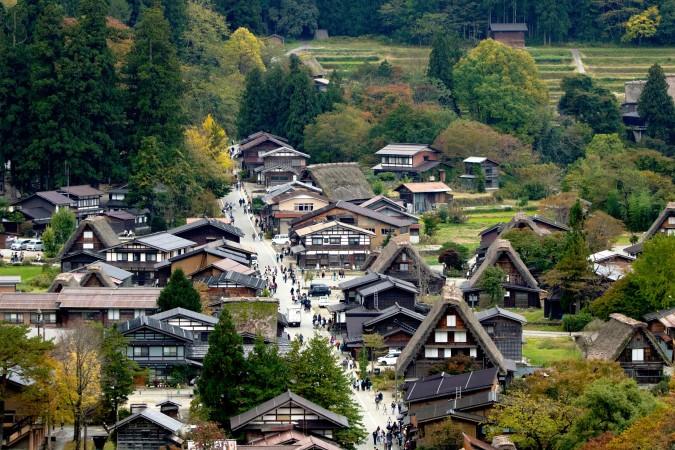
Top Attractions in Shirakawa-go
- Ogimachi Village: The heart of Shirakawa-go, Ogimachi Village is a living museum of gassho-zukuri houses, some over 250 years old. Stroll past rice fields, quaint gardens, and wooden bridges while taking in the peaceful mountain air. Many homes double as museums, offering a glimpse into rural life from centuries past.
- Wada House: As the largest gassho-zukuri farmhouse in Ogimachi, Wada House stands as a proud reminder of the village’s prosperity during the silk trade era. Visitors can explore its preserved interiors with tatami rooms, wooden beams, and the attic once used for sericulture.
- Shiroyama Viewpoint: For that postcard-perfect shot, climb to Shiroyama Viewpoint. From here, the panoramic view of the village against a backdrop of mountains is unforgettable, especially during winter’s snow blanket or autumn’s crimson foliage.
- Myōzen-ji Temple: Unique among Buddhist temples, Myōzen-ji has a gassho-zukuri-style main hall. The temple grounds are serene, dotted with mossy stones, wooden gates, and seasonal flowers, ideal for a quiet moment of reflection.
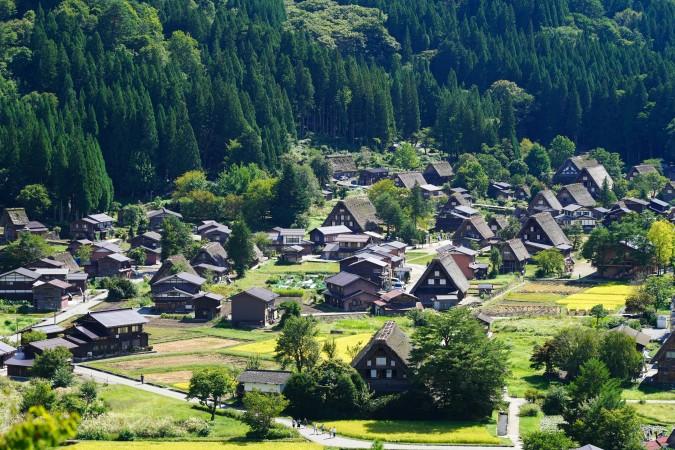
Must-Try Dishes in Shirakawa-go
- Hoba Miso: Hoba Miso blends miso paste with green onions, mushrooms, and sometimes minced meat, grilled on a dried magnolia leaf over a charcoal flame. The smoky aroma and deep umami flavor make it a comforting countryside meal.
- Gohei Mochi: This traditional snack features pounded rice shaped into flat ovals, skewered, and coated with a sweet miso or walnut sauce before being grilled. Gohei Mochi is soft, nutty, and slightly smoky, perfect for a quick bite while exploring.
- Hida Beef: Renowned for its delicate marbling, Hida Beef is one of Japan’s finest wagyu varieties. Enjoy it seared on a hot plate, grilled as yakiniku, or simmered in sukiyaki during colder months. Its buttery texture melts in your mouth.
- Sansai Dishes (Mountain Vegetables): In spring, the region bursts with fresh sansai such as warabi (bracken), fuki (butterbur), and kogomi (ostrich fern). These wild vegetables are often served as tempura, pickled, or in miso soup, bringing a taste of the mountains to your table.
- Ayu (Sweetfish): Caught from the nearby rivers, Ayu is salt-grilled and served whole, its mild flavor enhanced by the crisp skin and tender flesh. It’s a summertime delicacy.
- Kei-chan Chicken: A hearty local dish, Kei-chan features chicken marinated in miso, soy sauce, or garlic-based sauces, then stir-fried with cabbage and onions. It’s flavorful, rustic, and best enjoyed hot off the pan.
- Hoba Sushi: Unique to this region, Hoba Sushi is pressed sushi wrapped in magnolia leaves. The leaves infuse a subtle aroma, keeping the fish fresh and adding a distinctive twist to the classic Japanese dish.
- Mitarashi Dango: A sweet treat of skewered rice dumplings glazed with soy-based syrup. Mitarashi Dango is chewy, lightly sweet, and often sold at small teahouses in the village.
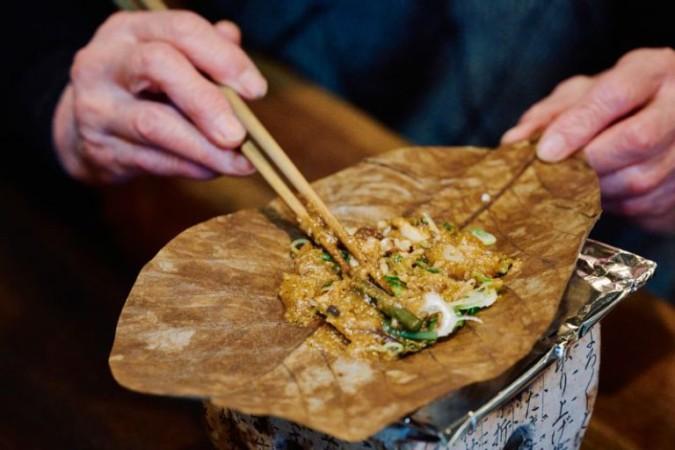
Festivals & Local Celebrations
Doburoku Festival
Held every October, the Doburoku Festival celebrates the harvest and pays homage to the village’s guardian deities. The highlight is the offering of doburoku, a thick, unrefined sake brewed locally. Visitors can watch traditional lion dances, listen to folk music, and taste the freshly brewed sake.
Shirakawa-go Winter Light-Up
On select nights in January and February, the Shirakawa-go Winter Light-Up transforms the snow-covered village into a glowing wonderland. The gassho-zukuri houses, blanketed in white, are illuminated against the dark mountain backdrop, creating one of Japan’s most magical winter scenes. This event draws photographers and travelers from around the world.

What to Do in Shirakawa-go
- Walking Tours: The best way to discover Shirakawa-go is on foot. Wander through winding lanes lined with gassho-zukuri houses, rice paddies, and wooden bridges. Guided tours offer deeper insights into the village’s history, architecture, and folklore.
- Photography: Each season offers a unique canvas, snow-capped rooftops in winter, pink cherry blossoms in spring, lush green fields in summer, and fiery foliage in autumn. The Shiroyama Viewpoint is perfect for wide village panoramas, while narrow alleys provide intimate close-up shots.
- Cycling & Hiking: In warmer months, rent a bicycle to explore beyond Ogimachi Village or follow gentle hiking trails to nearby hamlets. The surrounding mountains reveal scenic vistas, waterfalls, and hidden shrines.
- Cultural Workshops: Participate in hands-on experiences such as washi paper making, weaving, pottery, and local cooking classes. These activities deepen your connection to the village’s traditions.
Shopping in Shirakawa-go
- Local Crafts: Shirakawa-go is known for its handmade washi paper, pottery, and wooden carvings. These crafts reflect the skill and patience of local artisans.
- Unique Souvenirs: Popular mementos include miniature gassho-zukuri house models, doburoku sake bottles, and woven straw ornaments. Many are made by hand, making each piece unique.
- Regional Food Products: Bring home regional flavors such as miso paste, pickled vegetables, sansai (mountain vegetables), and locally milled rice. Specialty sweets like mitarashi dango and gohei mochi are also available packaged for travel.
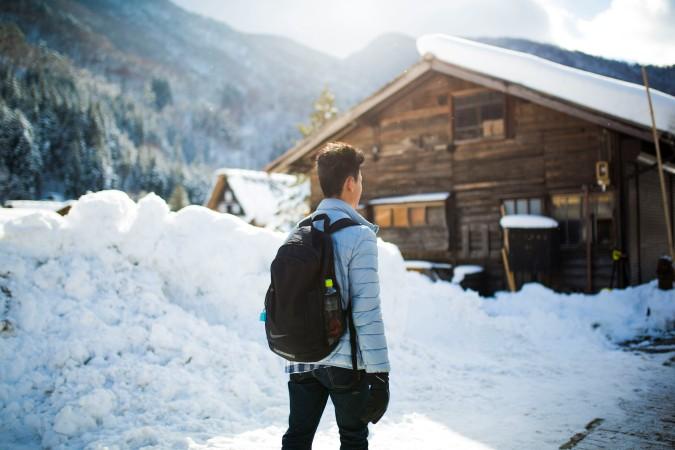
Weather in Shirakawa-go: Best Time to Visit
Spring (March – May)
Cherry blossoms bloom from mid- to late April, marking a shift to milder weather. Average temperatures range from 2°C to 18°C (36°F to 64°F). Melting snow reveals green fields, making it a perfect season for walking tours and photography.
Summer (June – August)
Lush rice paddies and cool mountain breezes define summer here. Average temperatures range from 17°C to 28°C (63°F to 82°F). While generally cooler than much of Japan, expect occasional rain showers during the June rainy season.
Autumn September – November)
Autumn transforms the village into vibrant shades of red, orange, and gold. Average temperatures range from 5°C to 21°C (41°F to 70°F). Crisp air and clear skies make this the ideal time for hiking and outdoor activities.
Winter (December – February)
Shirakawa-go is renowned for its heavy snowfall, often exceeding two meters. Average temperatures range from -5°C to 3°C (23°F to 37°F). The gassho-zukuri houses look magical under a thick layer of snow, especially during the Winter Light-Up events. Warm clothing, gloves, and sturdy snow boots are essential.
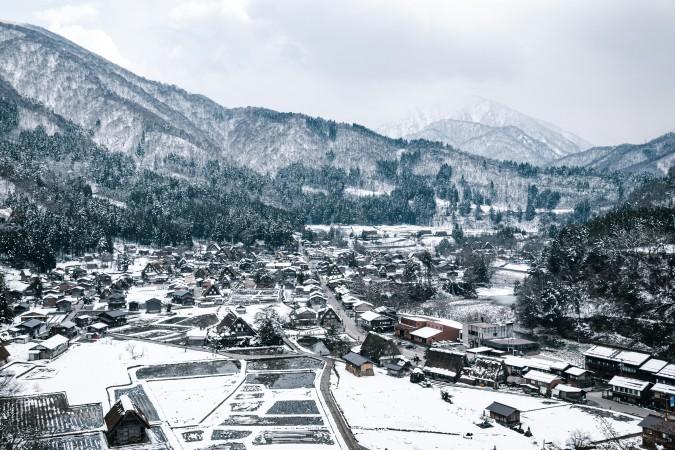
Essential Travel Information
Getting Around Shirakawa-go
- By Car: Driving offers flexibility, but winter roads can be icy and hazardous. Parking is available at designated lots located outside the village, with shuttle buses providing transportation to the center.
- Within the Village: Shirakawa-go is best explored on foot. Walking paths connect all major attractions, and cycling is available in warmer months. During winter, expect snow-packed routes, so wear sturdy boots.
- Travel Tips For First-Time Travellers: Public transport is reliable but can be limited in frequency, especially in the evening. Plan return trips in advance. In peak seasons and during the Winter Light-Up, buses may require reservations in advance.
ATM & Banking Services
Shirakawa-go has very few ATMs, and not all accept international cards. The main option is at the local post office, which often supports foreign-issued debit and credit cards. Many guesthouses, small restaurants, and shops operate on a cash-only basis. It’s best to withdraw enough yen before arriving, especially if you plan to stay overnight or shop for local crafts. Full-service banking facilities are located in nearby towns such as Takayama and Hakusan. Travelers should handle major currency exchanges before visiting.
Where to Stay in Shirakawa-go
- Gassho-Zukuri Minshuku: For the most authentic stay, book a minshuku inside a gassho-zukuri farmhouse. These family-run inns offer tatami mat rooms, futon bedding, and home-cooked meals, giving you a taste of rural life.
- Ryokan: Some ryokan blend traditional design with modern comforts, often including onsen baths, multi-course kaiseki dinners, and scenic mountain views.
- Guesthouses & Budget Stays: For travelers on a budget, guesthouses and dorm-style lodgings offer simple facilities and shared common areas, perfect for meeting other visitors.
Day Trips vs. Overnight
While many visitors come on day trips, staying overnight lets you experience the quiet, lantern-lit village after the tour buses leave, as well as early morning views before the crowds arrive.
Articles for you

Explore Yala National Park - Sri Lanka Travel, Asia
Tucked away in Sri Lanka’s southeastern corner, Yala National Park is where wild nature meets deep tradition. Known worldwide for its leopard population, the park is also home to elephants, sloth bears, crocodiles, and hundreds of bird species. Beyond wildlife, Yala opens doors to a cultural landscape dotted with ancient temples, Buddhist ruins, and coastal villages. For travelers seeking more than just a safari, Yala offers a chance to explore eco-tourism, local communities, and sacred heritage sites.
Population: The Yala National Park area doesn’t have a human population.
Economy: The economy around Yala National Park thrives on a blend of eco-tourism, agriculture, and local services. Safari tours, eco-lodges, and cultural experiences drive steady income for nearby towns like Tissamaharama and Kataragama, supporting thousands of families.
Landmarks: Famous for Block I of Yala and wildlife encounters, including elephants, sloth bears, crocodiles, and exotic bird species.

Explore Galle - Sri Lanka Travel, Asia
Nestled on Sri Lanka’s southern coastline, Galle is a vibrant city where history meets the sea. Its cobbled streets, colonial architecture, and serene beaches make it a must-visit destination for travelers seeking a blend of culture, adventure, and relaxation. A UNESCO World Heritage site, Galle captivates visitors with its Dutch Fort, bustling markets, and friendly locals. Whether you’re exploring the ramparts at sunset or savoring fresh seafood by the shore, Galle promises an unforgettable journey into Sri Lanka’s heritage.
Population: Approximately 113,000 in 2023.
Economy: Galle’s economy thrives on tourism, trade, and fisheries. The city’s historic fort, colonial architecture, and coastal charm draw thousands of international visitors each year, making tourism its main economic driver. Fishing remains vital for local livelihoods, supplying fresh seafood across the region.
Landmarks: Famous for the Galle Fort, Dutch Reformed Church & Maritime Museum, and Unawatuna Beach.

Explore Bentota - Sri Lanka Travel, Asia
Nestled along Sri Lanka’s southwestern coast, Bentota is a tropical paradise that blends golden beaches, vibrant culture, and thrilling adventures. Famous for its calm waters, luxury resorts, and scenic river estuary, Bentota has become a top destination for travelers seeking both relaxation and authentic experiences. From serene beach walks at sunrise to adrenaline-pumping water sports, this coastal town offers a perfect balance of leisure and exploration. With its proximity to Colombo and Galle, Bentota is easy to reach, making it an ideal stop for both short escapes and extended holidays.
Population: Approximately 37,000 in 2023.
Economy: Bentota’s economy thrives mainly on tourism, which drives local businesses such as hotels, restaurants, and wellness retreats. The town also benefits from fishing, coconut cultivation, and handicrafts like wood carving and batik textiles. Many residents rely on the growing demand for water sports and Ayurvedic treatments, making tourism the backbone of both income and employment in the area.
Landmarks: Famous for Bentota Beach, Bentota River Safari, and Kande Vihara Temple.

Explore Mirissa - Sri Lanka Travel, Asia
Mirissa is a charming coastal town on Sri Lanka’s southern shoreline. Known for its golden beaches, turquoise waters, and vibrant marine life, it has become a must-visit stop for travelers exploring the island. Many come for whale watching, surfing, and sunset views at Coconut Tree Hill, but Mirissa offers much more than postcard beauty. The fishing boats you see anchored by the bay carry generations of stories. Local traditions, delicious cuisine, and a laid-back rhythm of life shape every visitor’s experience.
Population: Approximately 4,700 in 2023.
Economy: Mirissa’s economy is largely shaped by its coastal location. Fishing has long been the backbone of local livelihoods, with generations relying on the Indian Ocean for income. In recent decades, tourism has become the main driver of growth, thanks to whale watching, surfing, and beachside hospitality.
Landmarks: Famous for Mirissa Beach, Coconut Tree Hill, and Parrot Rock Bridge.

Explore Nuwara Eliya - Sri Lanka Travel, Asia
Tucked away in the Central Highlands of Sri Lanka, Nuwara Eliya is often called “Little England”. With its rolling tea plantations, cool misty mornings, and colonial charm, this mountain town feels like a step into another world. Travelers come here to breathe fresh air, walk through flower gardens, sip the finest Ceylon Tea, and enjoy a pace of life far from the island’s busy cities. Whether you’re drawn by scenic landscapes, heritage architecture, or the warmth of its people, Nuwara Eliya is a destination that blends nature, culture, and history in perfect harmony.
Population: Approximately 781,000 in 2023.
Economy: Nuwara Eliya’s economy thrives mainly on tea production, as it sits in the heart of Sri Lanka’s central highlands, famous worldwide for Ceylon Tea. The city also benefits from a growing tourism industry, attracting visitors with its colonial charm, cool climate, and scenic landscapes.
Landmarks: Famous for Gregory Lake, Hakgala Botanical Garden, and Victoria Park.

Explore Sukau - Malaysia Travel, Asia
Nestled on the banks of the Kinabatangan River in Sabah, Malaysian Borneo, Sukau is a destination where wildlife, culture, and conservation come together. Known as one of Asia’s top spots for river safaris and eco-tourism, this quiet village offers a front-row seat to encounters with Bornean orangutans, pygmy elephants, proboscis monkeys, and exotic birdlife.
Population: Approximately 1,400 in 2019.
Economy: Sukau’s economy is shaped by its riverine location and natural resources. Traditionally, the Orang Sungai community relied on fishing, small-scale farming, and forest gathering for their livelihood. Today, the village has shifted toward eco-tourism, with river cruises, jungle trekking, and homestays providing income.
Landmarks: Famous for the Kinabatangan River cruises, Gomantong Caves, and Ox-bow lakes and wetlands.
